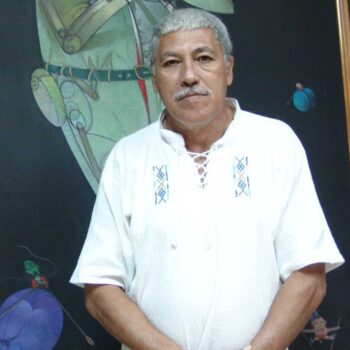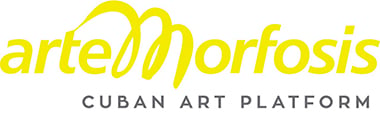
Pedro Pablo Oliva
Nobody was surprised when Pedro Pablo Oliva (1949, Pinar del Río) was announced the winner of the National Prize in Visual Art in 2006. As stated by David Mateo, this was, “a prize of public consensus.” And it is, because Oliva’s work is, undoubtedly, among the greatest examples of visual arts in the Island. The far-reaching distinction was not the initial recognition already ensured many years ago by said “public consensus”, but merely a confirmation of the substantial contribution made by this creator with his work and of his preeminent place in the history of Cuban art.
Pedro Pablo Oliva’s work has been marked by the spirit of the so-called “generation of true hope” that flooded the Cuban art scene during the troubled decade of the 1970s. Those artists were molded, artistically and ideologically, in the late 1960s in the classrooms and workshops of the National School of Arts of Cubanacán, first of its kind founded by the still young Cuban Revolution. That academic training, the staff members, and an improbable mixture of nostalgia and utopian projection (in addition to which a certain sense of urgency exhorted to retake and concretize the search for a national idiosyncratic expression) ended by attracting many of these artists, in their form and spirit, to the project of the first Cuban modernity. Those were years of bursting lyricism and utopian idealism disguised as realism, concretized in works that praised rural life, the anonymous faces of the people, and the epic of the daily individual symbolically validated by the revolutionary power. This imagery and its tradition were then flaunted generation with the fusion of a critical inquiry of daily life, a spirit of avant-garde and the notion of an art willing to act as agent of spiritual and social change.
Videos
Faces of an Island:
- Artist Welcome to exhibition
Retrospective:
- Introduction & Commentaries
Catalog
Virtual Reality Exhibitions
Faces of an Island:
- Computers | Phones and Pads
Retrospective:
- Computers | Phones and Pads
Curriculum
Pedro Pablo Oliva (* 1949, Pinar del Río) is one of the most outstanding artists in the Cuban art world. He studied painting from 1961 to 1964 at the Elementary School of Visual Arts and the School of Applied Visual Arts in Pinar del Río, and from 1965 to 1970 at the National Art School (ENA) in Havana. From 1970 to 1985, he taught as a professor of drawing and painting in Havana, Matanzas, and Pinar del Río. Since 1985, he has worked as a freelance artist. He is a member of the National Union of Writers and Artists of Cuba (UNEAC) and the International Association of Art (AIAP). In recognition of his role as a mentor to several generations of young artists, Oliva was appointed Honorary Professor of the Higher Institute of Art (ISA) in Havana.
2016
El largo y lento viaje de una utopía (Die lange und langsame Reise einer Utopie). Haus der Jungen Kunstschaffenden, AHS, Pinar del Río, Kuba
Apuntes de viajes (Reisenotizen). Entwicklungszentrum für Visuelle Künste, Pinar del Río, Kuba
Apuntes de viajes (Reisenotizen). Galerie der Öffentlichen Bibliothek „Rubén Martínez Villena“, Havanna, Kuba
2015
Utopías y disidencias (Utopien und Zwistigkeiten). Kunststudio La Mina, 12. Biennale von Havanna, Havanna, Kuba
2014
Utopías y disidencias (Utopien und Zwistigkeiten). Kunststudio Pinar del Río, Kuba
Extraños estudios para mi mano temblorosa (Seltsame Studien für meine zittrige Hand). Kongresspalast, Havanna, Kuba
2013
Pequeñas cosas. Pedro Pablo Oliva, obras recientes (Kleine Dinge. Pedro Pablo Oliva, Neue Werke). Latin Art Core, Miami, USA
Extraños estudios para mi mano temblorosa (Seltsame Studien für meine zittrige Hand). Dokumentationszentrum. Zentrum für
Neurologische Wiederherstellung (CIREN), Havanna, Kuba
2012
Pedro Pablo Oliva, obra reciente (Neues Werk). Kunststudio La Mina, Havanna, Kuba
2008
Unfulfilled promises (Unerfüllte Versprechen). Panamerican Art Projects, Miami, USA
2007
Historia de amor (Liebesgeschichte). Nationalmuseum für Schöne Künste, Havanna, Kuba
2003
Papeles nocturnos (Nächtliche Papiere). Galerie der Provinz Las Tunas, Kuba
2002
Papeles nocturnos (Nächtliche Papiere). Galerie Domingo Padrón, Miami, USA
2000
Quiero pintar en paz... (Ich möchte in Frieden malen...), Galerie La Acacia, Havanna, Kuba
1995
El gran apagón (Der grosse Stromausfall). Kunstgalerie der Provinz Pinar del Río, Kuba
1992
Pedro Pablo Oliva. Obras recientes (Neue Werke). Bernheim Gallery, Panama
Pedro Pablo Oliva. Sindin Gallery, New York, USA
1991
Pedro Pablo Oliva. Diálogo con su magia. (Dialog mit seiner Magie). Galerie La Acacia, Havanna, Kuba
1984
Pedro Pablo Oliva. Pinturas, dibujos, bocetos y otros pasatiempos (Bilder, Zeichnungen, Skizzen und anderer Zeitvertreib). Nationalmuseum für Schöne Künste, Havanna, Kuba
1980
Ausstellung Pedro Pablo Oliva. Nationalmuseum für Schöne Künste, Havanna, Kuba
1979
Pedro Pablo Oliva. Kunstgalerie, Pinar del Río, Kuba
1978
Oliva y las imágenes de su pueblo (Oliva und die Bilder seiner Stadt). Galerie Habana, Kuba
1977
El artista del mes (Künstler des Monats). Nationalmuseum für Schöne Künste, Havanna, Kuba
Pedro Pablo Oliva. Kleiner Salon, Nationalmuseum für Schöne Künste, Havanna, Kuba
1974
El artista del mes (Künstler des Monats). Nationalmuseum für Schöne Künste, Havanna, Kuba





















